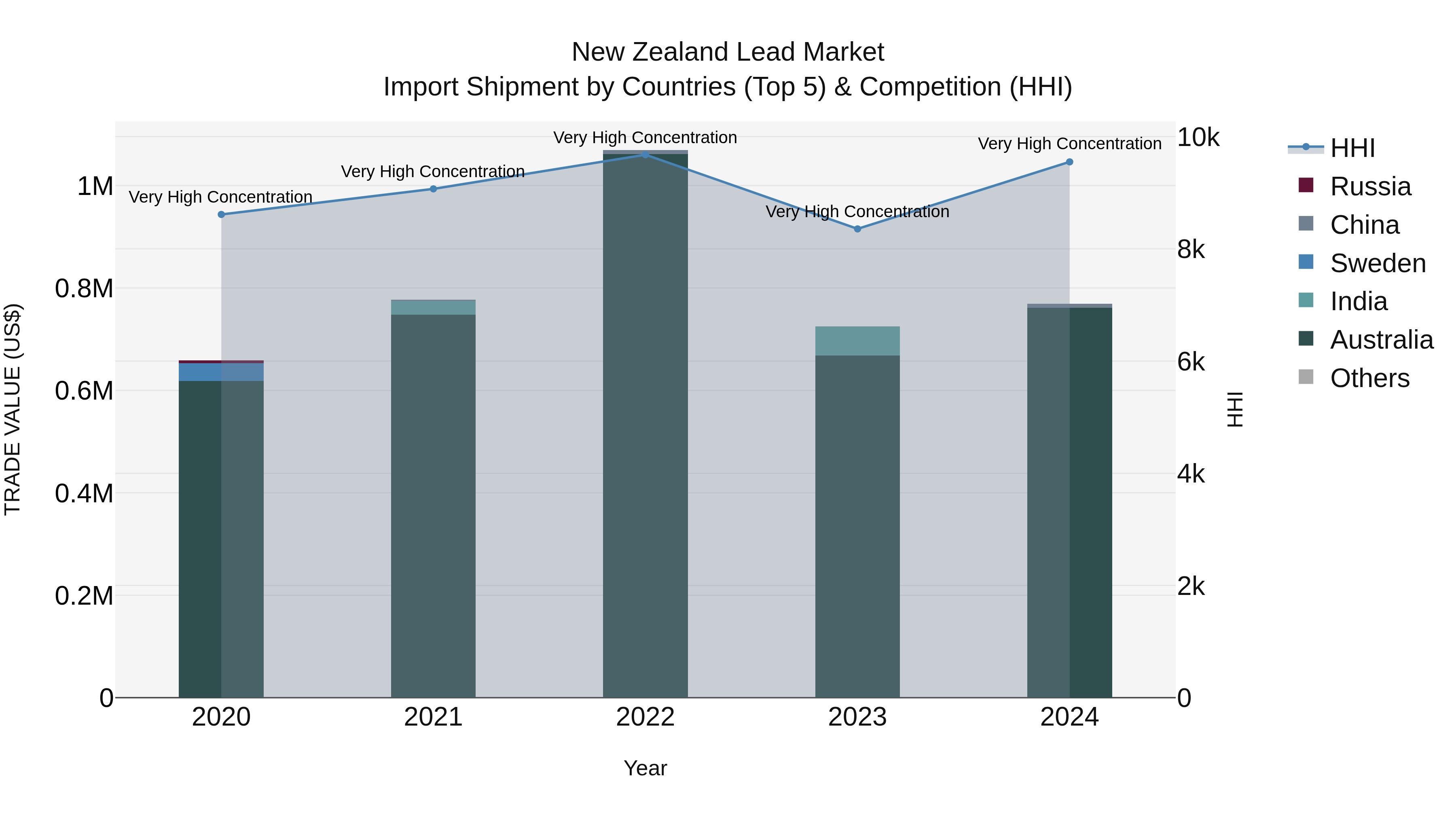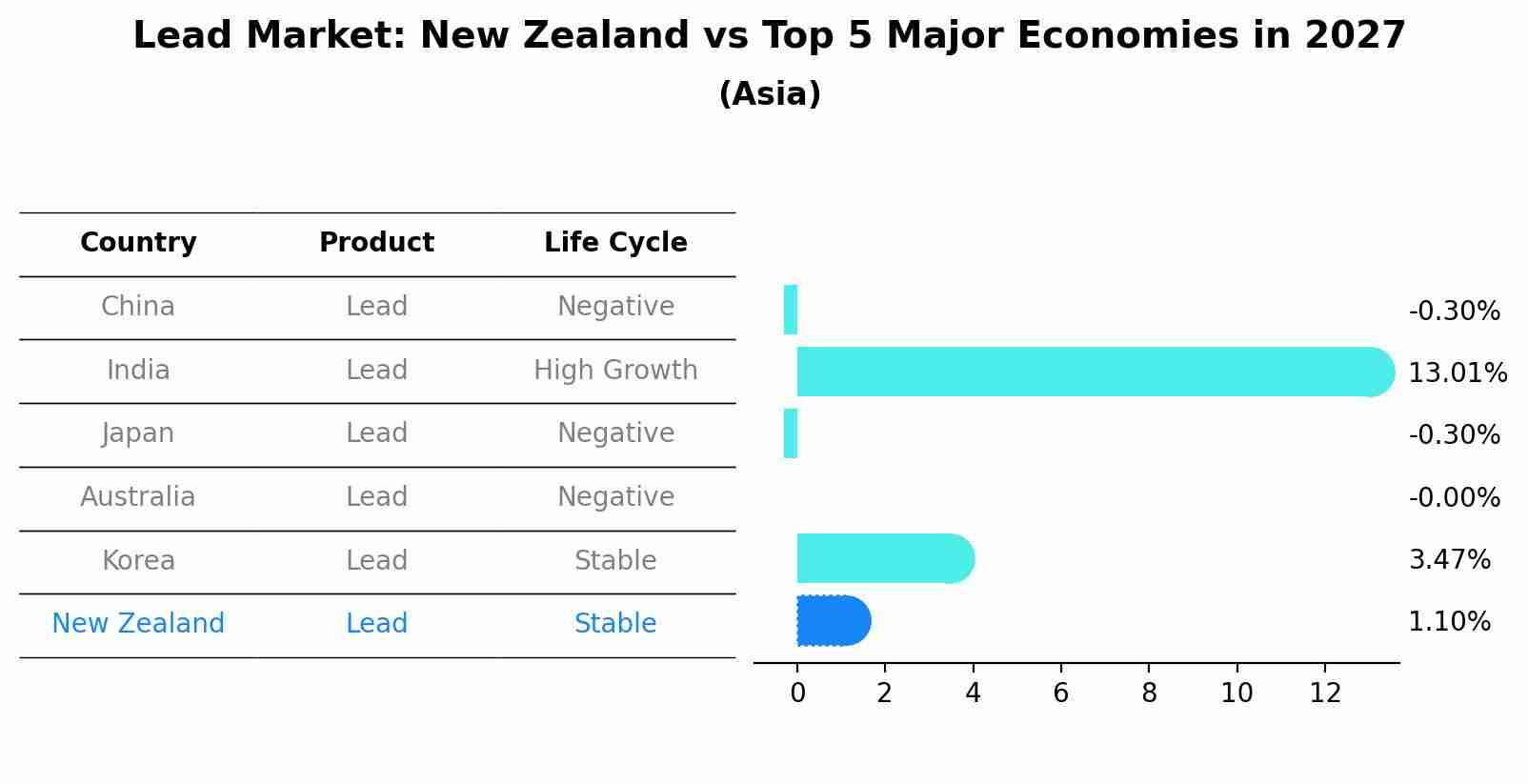New Zealand Lead Market (2025-2031) | Growth, Size, Forecast, Share, Industry, Outlook, Companies, Value, Analysis, Trends, Segmentation & Revenue
| Product Code: ETC4655610 | Publication Date: Nov 2023 | Updated Date: Nov 2025 | Product Type: Market Research Report | |
| Publisher: 6Wresearch | Author: Shubham Padhi | No. of Pages: 60 | No. of Figures: 30 | No. of Tables: 5 |
New Zealand Lead Market Top 5 Importing Countries and Market Competition (HHI) Analysis
In 2024, New Zealand`s lead import market continued to showcase strong growth, with key suppliers like Australia, China, India, Russia, and Sweden dominating the landscape. The high concentration levels, as indicated by the HHI, suggest a competitive market environment. The compound annual growth rate (CAGR) over the period 2020-24 was a steady 3.98%, with a notable growth spurt of 6.15% from 2023 to 2024. This indicates a robust demand for lead imports in New Zealand, with a diverse range of countries contributing to the market`s expansion.

Lead Market: New Zealand vs Top 5 Major Economies in 2027 (Asia)
By 2027, New Zealand's Lead market is forecasted to achieve a stable growth rate of 1.10%, with China leading the Asia region, followed by India, Japan, Australia and South Korea.

Key Highlights of the Report:
- New Zealand Lead Market Outlook
- Market Size of New Zealand Lead Market, 2024
- Forecast of New Zealand Lead Market, 2031
- Historical Data and Forecast of New Zealand Lead Revenues & Volume for the Period 2021-2031
- New Zealand Lead Market Trend Evolution
- New Zealand Lead Market Drivers and Challenges
- New Zealand Lead Price Trends
- New Zealand Lead Porter`s Five Forces
- New Zealand Lead Industry Life Cycle
- Historical Data and Forecast of New Zealand Lead Market Revenues & Volume By Isotopesfor the Period 2021-2031
- Historical Data and Forecast of New Zealand Lead Market Revenues & Volume By Lead-204 for the Period 2021-2031
- Historical Data and Forecast of New Zealand Lead Market Revenues & Volume By Lead-207 for the Period 2021-2031
- Historical Data and Forecast of New Zealand Lead Market Revenues & Volume By Lead-206 for the Period 2021-2031
- Historical Data and Forecast of New Zealand Lead Market Revenues & Volume By Lead-208 for the Period 2021-2031
- Historical Data and Forecast of New Zealand Lead Market Revenues & Volume By Applications for the Period 2021-2031
- Historical Data and Forecast of New Zealand Lead Market Revenues & Volume By Batteries for the Period 2021-2031
- Historical Data and Forecast of New Zealand Lead Market Revenues & Volume By Cable sheaths for the Period 2021-2031
- Historical Data and Forecast of New Zealand Lead Market Revenues & Volume By Shipbuilding for the Period 2021-2031
- Historical Data and Forecast of New Zealand Lead Market Revenues & Volume By Light industry for the Period 2021-2031
- Historical Data and Forecast of New Zealand Lead Market Revenues & Volume By Others for the Period 2021-2031
- Historical Data and Forecast of New Zealand Lead Market Revenues & Volume By End-users for the Period 2021-2031
- Historical Data and Forecast of New Zealand Lead Market Revenues & Volume By Mechanical Industry for the Period 2021-2031
- Historical Data and Forecast of New Zealand Lead Market Revenues & Volume By Construction Industry for the Period 2021-2031
- Historical Data and Forecast of New Zealand Lead Market Revenues & Volume By Defense for the Period 2021-2031
- Historical Data and Forecast of New Zealand Lead Market Revenues & Volume By Electronics for the Period 2021-2031
- Historical Data and Forecast of New Zealand Lead Market Revenues & Volume By Others for the Period 2021-2031
- New Zealand Lead Import Export Trade Statistics
- Market Opportunity Assessment By Isotopes
- Market Opportunity Assessment By Applications
- Market Opportunity Assessment By End-users
- New Zealand Lead Top Companies Market Share
- New Zealand Lead Competitive Benchmarking By Technical and Operational Parameters
- New Zealand Lead Company Profiles
- New Zealand Lead Key Strategic Recommendations
Frequently Asked Questions About the Market Study (FAQs):
1 Executive Summary |
2 Introduction |
2.1 Key Highlights of the Report |
2.2 Report Description |
2.3 Market Scope & Segmentation |
2.4 Research Methodology |
2.5 Assumptions |
3 New Zealand Lead Market Overview |
3.1 New Zealand Country Macro Economic Indicators |
3.2 New Zealand Lead Market Revenues & Volume, 2021 & 2031F |
3.3 New Zealand Lead Market - Industry Life Cycle |
3.4 New Zealand Lead Market - Porter's Five Forces |
3.5 New Zealand Lead Market Revenues & Volume Share, By Isotopes? , 2021 & 2031F |
3.6 New Zealand Lead Market Revenues & Volume Share, By Applications, 2021 & 2031F |
3.7 New Zealand Lead Market Revenues & Volume Share, By End-users, 2021 & 2031F |
4 New Zealand Lead Market Dynamics |
4.1 Impact Analysis |
4.2 Market Drivers |
4.2.1 Increasing demand for renewable energy sources |
4.2.2 Growing adoption of electric vehicles |
4.2.3 Government initiatives promoting sustainable practices |
4.3 Market Restraints |
4.3.1 Fluctuating prices of lead in the global market |
4.3.2 Environmental concerns related to lead mining and usage |
5 New Zealand Lead Market Trends |
6 New Zealand Lead Market Segmentations |
6.1 New Zealand Lead Market, By Isotopes? |
6.1.1 Overview and Analysis |
6.1.2 New Zealand Lead Market Revenues & Volume, By Lead-204, 2021-2031F |
6.1.3 New Zealand Lead Market Revenues & Volume, By Lead-207, 2021-2031F |
6.1.4 New Zealand Lead Market Revenues & Volume, By Lead-206, 2021-2031F |
6.1.5 New Zealand Lead Market Revenues & Volume, By Lead-208, 2021-2031F |
6.2 New Zealand Lead Market, By Applications |
6.2.1 Overview and Analysis |
6.2.2 New Zealand Lead Market Revenues & Volume, By Batteries, 2021-2031F |
6.2.3 New Zealand Lead Market Revenues & Volume, By Cable sheaths, 2021-2031F |
6.2.4 New Zealand Lead Market Revenues & Volume, By Shipbuilding, 2021-2031F |
6.2.5 New Zealand Lead Market Revenues & Volume, By Light industry, 2021-2031F |
6.2.6 New Zealand Lead Market Revenues & Volume, By Others, 2021-2031F |
6.3 New Zealand Lead Market, By End-users |
6.3.1 Overview and Analysis |
6.3.2 New Zealand Lead Market Revenues & Volume, By Mechanical Industry, 2021-2031F |
6.3.3 New Zealand Lead Market Revenues & Volume, By Construction Industry, 2021-2031F |
6.3.4 New Zealand Lead Market Revenues & Volume, By Defense, 2021-2031F |
6.3.5 New Zealand Lead Market Revenues & Volume, By Electronics, 2021-2031F |
6.3.6 New Zealand Lead Market Revenues & Volume, By Others, 2021-2031F |
7 New Zealand Lead Market Import-Export Trade Statistics |
7.1 New Zealand Lead Market Export to Major Countries |
7.2 New Zealand Lead Market Imports from Major Countries |
8 New Zealand Lead Market Key Performance Indicators |
8.1 Percentage of lead recycled in New Zealand |
8.2 Number of electric vehicles on the road powered by lead-acid batteries |
8.3 Investment in research and development for lead battery technology |
9 New Zealand Lead Market - Opportunity Assessment |
9.1 New Zealand Lead Market Opportunity Assessment, By Isotopes? , 2021 & 2031F |
9.2 New Zealand Lead Market Opportunity Assessment, By Applications, 2021 & 2031F |
9.3 New Zealand Lead Market Opportunity Assessment, By End-users, 2021 & 2031F |
10 New Zealand Lead Market - Competitive Landscape |
10.1 New Zealand Lead Market Revenue Share, By Companies, 2024 |
10.2 New Zealand Lead Market Competitive Benchmarking, By Operating and Technical Parameters |
11 Company Profiles |
12 Recommendations | 13 Disclaimer |
- Single User License$ 1,995
- Department License$ 2,400
- Site License$ 3,120
- Global License$ 3,795
Search
Thought Leadership and Analyst Meet
Our Clients
Related Reports
- Canada Oil and Gas Market (2026-2032) | Share, Segmentation, Value, Industry, Trends, Forecast, Analysis, Size & Revenue, Growth, Competitive Landscape, Outlook, Companies
- Germany Breakfast Food Market (2026-2032) | Industry, Share, Growth, Size, Companies, Value, Analysis, Revenue, Trends, Forecast & Outlook
- Australia Briquette Market (2025-2031) | Growth, Size, Revenue, Forecast, Analysis, Trends, Value, Share, Industry & Companies
- Vietnam System Integrator Market (2025-2031) | Size, Companies, Analysis, Industry, Value, Forecast, Growth, Trends, Revenue & Share
- ASEAN and Thailand Brain Health Supplements Market (2025-2031) | Strategy, Consumer Insights, Analysis, Investment Trends, Opportunities, Growth, Size, Share, Industry, Revenue, Segments, Value, Segmentation, Supply, Forecast, Restraints, Outlook, Competition, Drivers, Trends, Demand, Pricing Analysis, Competitive, Strategic Insights, Companies, Challenges
- ASEAN Bearings Market (2025-2031) | Strategy, Consumer Insights, Analysis, Investment Trends, Opportunities, Growth, Size, Share, Industry, Revenue, Segments, Value, Segmentation, Supply, Forecast, Restraints, Outlook, Competition, Drivers, Trends, Demand, Pricing Analysis, Competitive, Strategic Insights, Companies, Challenges
- Europe Flooring Market (2025-2031) | Outlook, Share, Industry, Trends, Forecast, Companies, Revenue, Size, Analysis, Growth & Value
- Saudi Arabia Manlift Market (2025-2031) | Outlook, Size, Growth, Trends, Companies, Industry, Revenue, Value, Share, Forecast & Analysis
- Uganda Excavator, Crane, and Wheel Loaders Market (2025-2031) | Strategy, Consumer Insights, Analysis, Investment Trends, Opportunities, Growth, Size, Share, Industry, Revenue, Segments, Value, Segmentation, Supply, Forecast, Restraints, Outlook, Competition, Drivers, Trends, Demand, Pricing Analysis, Competitive, Strategic Insights, Companies, Challenges
- Rwanda Excavator, Crane, and Wheel Loaders Market (2025-2031) | Strategy, Consumer Insights, Analysis, Investment Trends, Opportunities, Growth, Size, Share, Industry, Revenue, Segments, Value, Segmentation, Supply, Forecast, Restraints, Outlook, Competition, Drivers, Trends, Demand, Pricing Analysis, Competitive, Strategic Insights, Companies, Challenges
Industry Events and Analyst Meet
Whitepaper
- Middle East & Africa Commercial Security Market Click here to view more.
- Middle East & Africa Fire Safety Systems & Equipment Market Click here to view more.
- GCC Drone Market Click here to view more.
- Middle East Lighting Fixture Market Click here to view more.
- GCC Physical & Perimeter Security Market Click here to view more.
6WResearch In News
- Doha a strategic location for EV manufacturing hub: IPA Qatar
- Demand for luxury TVs surging in the GCC, says Samsung
- Empowering Growth: The Thriving Journey of Bangladesh’s Cable Industry
- Demand for luxury TVs surging in the GCC, says Samsung
- Video call with a traditional healer? Once unthinkable, it’s now common in South Africa
- Intelligent Buildings To Smooth GCC’s Path To Net Zero


















